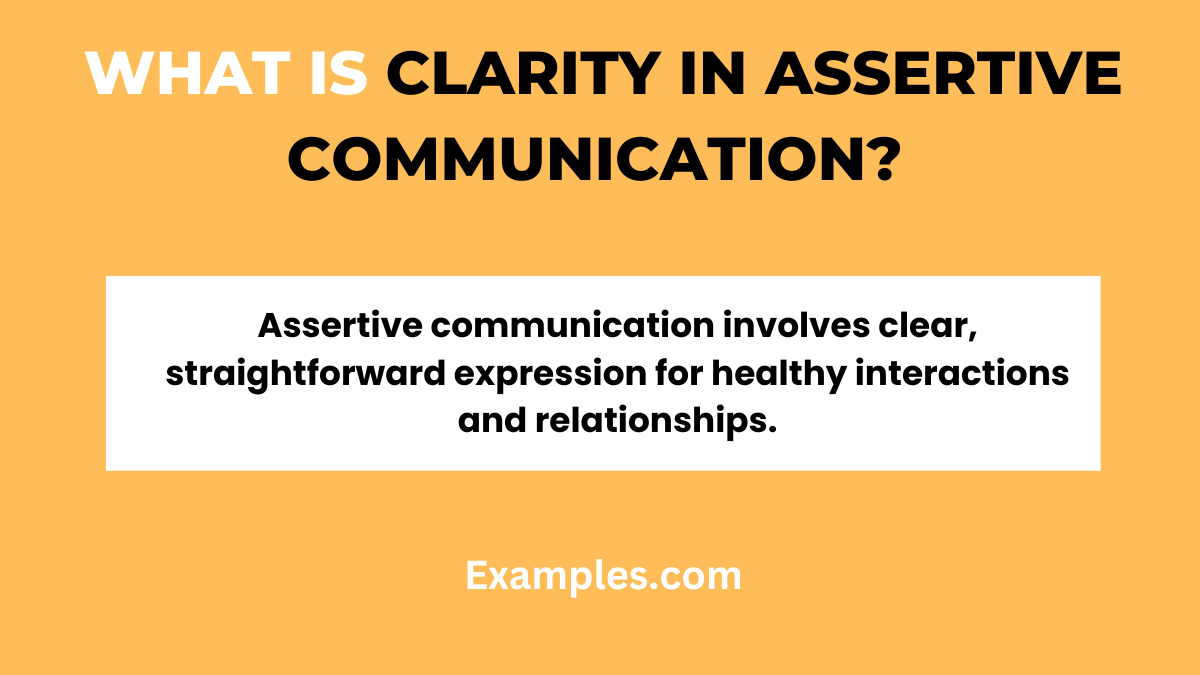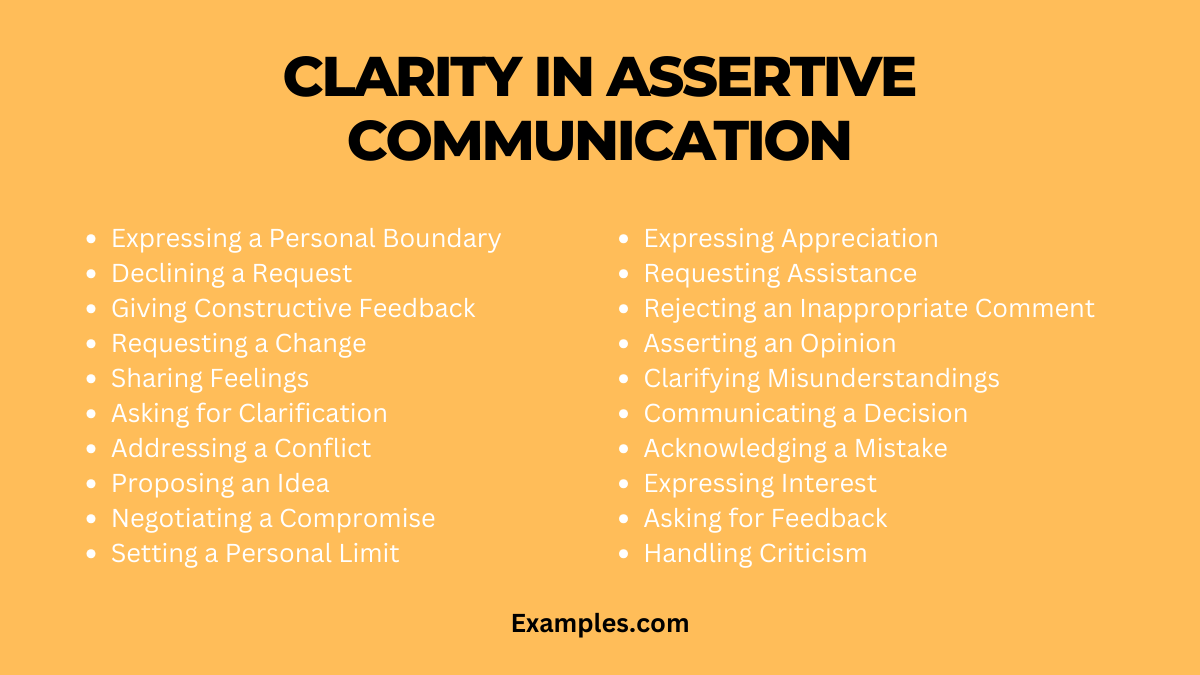19+ Clarity in Assertive Communication Examples
Assertive communication is a key skill in both personal and professional settings. This guide focuses on the importance of clarity in assertive communication, featuring practical Assertive Communication Examples and actionable tips. Learn how to express your needs and opinions clearly and respectfully, while maintaining a balance of empathy and firmness. From using “I statements” to managing body language, this guide provides valuable insights into effective and clear assertive communication.
What is Clarity in Assertive Communication?

Clarity in assertive communication is about expressing oneself in a straightforward and understandable manner. It involves being clear about your thoughts, feelings, and needs, without being aggressive or passive. This type of communication is key to building healthy relationships and effective interactions.
What is the Best Example of Clarity in Assertive Communication?

The best example of clarity in assertive communication is when someone expresses their needs or opinions directly and respectfully, without ambiguity or aggression. It’s about being honest and clear, while also considering the feelings and perspectives of others.
20 Clarity in Assertive Communication Examples

- Expressing a personal boundary: “I feel uncomfortable when personal space isn’t respected. Please maintain a respectful distance.”
- Declining a request: “I appreciate your offer, but I cannot commit to this project due to other priorities.”
- Giving constructive feedback: “Your report was well-researched, but I suggest adding more data analysis for clarity.”
- Requesting a change: “I would prefer if we could start our meetings earlier to accommodate different time zones.”
- Sharing feelings: “I feel undervalued when my contributions are not acknowledged.”
- Asking for clarification: “Could you please explain what you mean by ‘streamlining the process’?”

- Addressing a conflict: “I noticed we have differing views on this project. Can we discuss a middle ground?”
- Proposing an idea: “I believe implementing a new software will enhance our workflow efficiency.”
- Negotiating a compromise: “If we extend the deadline, I can ensure higher quality in the final output.”
- Setting a personal limit: “I can’t work late this week due to family commitments.”
- Expressing appreciation: “I really value your dedication to this project. Your efforts are making a difference.”
- Requesting assistance: “I need help understanding this concept. Can we schedule a time to discuss it?”
- Rejecting an inappropriate comment: “I find that remark offensive and would appreciate it if you refrained from such comments.”
- Asserting an opinion: “I believe that our focus should be on customer satisfaction first.”
- Clarifying misunderstandings: “There seems to be a misunderstanding. What I meant to say was…”
- Communicating a decision: “After careful consideration, I’ve decided to go with the second option.”
- Acknowledging a mistake: “I realize I missed the deadline, and I am taking steps to ensure it doesn’t happen again.”
- Expressing interest: “I’m really interested in this project and would like to be more involved.”
- Asking for feedback: “I would appreciate your input on my presentation style and content.”
- Handling criticism: “I understand your concerns and will work on improving those areas.”
Each of these examples demonstrates how clarity in assertive communication can effectively convey messages in various situations, fostering understanding and mutual respect.
Importance of Clarity in Assertive Communication
Clarity is the cornerstone of effective assertive communication. It involves expressing ideas and feelings in a straightforward and understandable manner, ensuring that the intended message is conveyed accurately. Clear assertive communication minimizes the risk of misunderstandings and conflicts, fostering a positive and productive dialogue. It allows individuals to express their needs and opinions confidently and respectfully, promoting healthy interactions in both personal and professional settings. By prioritizing clarity, assertive communicators can build stronger relationships, resolve conflicts more effectively, and create a more inclusive and empathetic environment.
1. Prevents Misunderstandings
Clarity in assertive communication ensures that messages are understood as intended, reducing the likelihood of misunderstandings. By expressing oneself clearly, one minimizes the chances of misinterpretation, fostering smoother interactions.
2. Enhances Effectiveness of Communication
Clear communication in an assertive manner increases the effectiveness of the message. It allows the audience to grasp the intent and substance of the message without ambiguity, making the communication more impactful.
3. Builds Trust and Credibility
When individuals communicate assertively and clearly, they build trust and credibility with their audience. Clarity shows that the communicator is confident and honest in their intentions, which enhances their reliability.
4. Improves Conflict Resolution
Clarity plays a crucial role in resolving conflicts. By articulating issues and perspectives clearly, individuals can address the root cause of conflicts more effectively, leading to quicker and more amicable resolutions.
5. Aids in Setting Boundaries
Assertive communication with clarity helps in setting and respecting boundaries. By articulating limits clearly, individuals ensure that their personal and professional boundaries are understood and respected.
6. Facilitates Constructive Feedback
Giving and receiving constructive feedback is pivotal in personal and professional growth. Clarity in assertive communication ensures that feedback is given in a manner that is helpful, specific, and actionable.
7. Encourages Open and Honest Expression
Clear and assertive communication fosters an environment of openness and honesty. It encourages individuals to express their true thoughts and feelings without fear of being misunderstood.
8. Strengthens Relationships
In both personal and professional relationships, clear and assertive communication strengthens bonds. It ensures that all parties are on the same page, leading to healthier and more productive relationships.
How to Communicate with Clarity in Assertive Communication?
Communicating with clarity in an assertive manner involves expressing oneself in a direct, straightforward, and respectful way. It requires understanding and effectively conveying one’s needs, feelings, and thoughts, while also being receptive to the perspectives of others. The goal is to express oneself honestly and openly without aggression or passivity, ensuring mutual understanding and respect. This approach not only enhances personal interactions but also contributes to a more effective and collaborative professional environment.
1. Use ‘I’ Statements
Employing ‘I’ statements helps in expressing thoughts and feelings directly and personally, enhancing clarity. It allows the communicator to own their messages without making the listener feel defensive.
2. Be Specific and Direct
Being specific and direct in communication ensures that the core message is conveyed without unnecessary details or ambiguity. This approach helps the listener understand exactly what is being said.
3. Practice Active Listening
Active listening in assertive communication involves giving full attention to the speaker and understanding their message. This practice helps in responding appropriately and clarifying any misunderstandings.
4. Maintain a Respectful Tone
Using a respectful tone, even when discussing sensitive issues, helps in maintaining clarity. It ensures that the focus remains on the message, not on emotional reactions.
5. Control Emotional Responses
Emotional control in assertive communication is key to maintaining clarity. By managing emotions, individuals can convey their messages more logically and effectively.
6. Utilize Clear Body Language
Body language should align with verbal messages for clarity. Clear and open body language reinforces the verbal message, making the overall communication more coherent.
7. Offer Constructive Feedback
Providing constructive feedback in a clear and focused manner is essential in assertive communication. It helps the recipient understand the areas of improvement and the steps they can take.
8. Be Consistent in Your Messages
Consistency in communication is important for clarity. Sending mixed messages can lead to confusion and misunderstanding, whereas consistency reinforces understanding and trust.
In summary, mastering assertive communication is key to effective interpersonal interactions. By following the tips and guidelines outlined in this guide, you can enhance your communication skills significantly. Remember, clarity in communication not only fosters understanding but also builds stronger relationships both in your personal and professional life. Practice assertiveness, and you’ll reap the benefits of improved communication.



